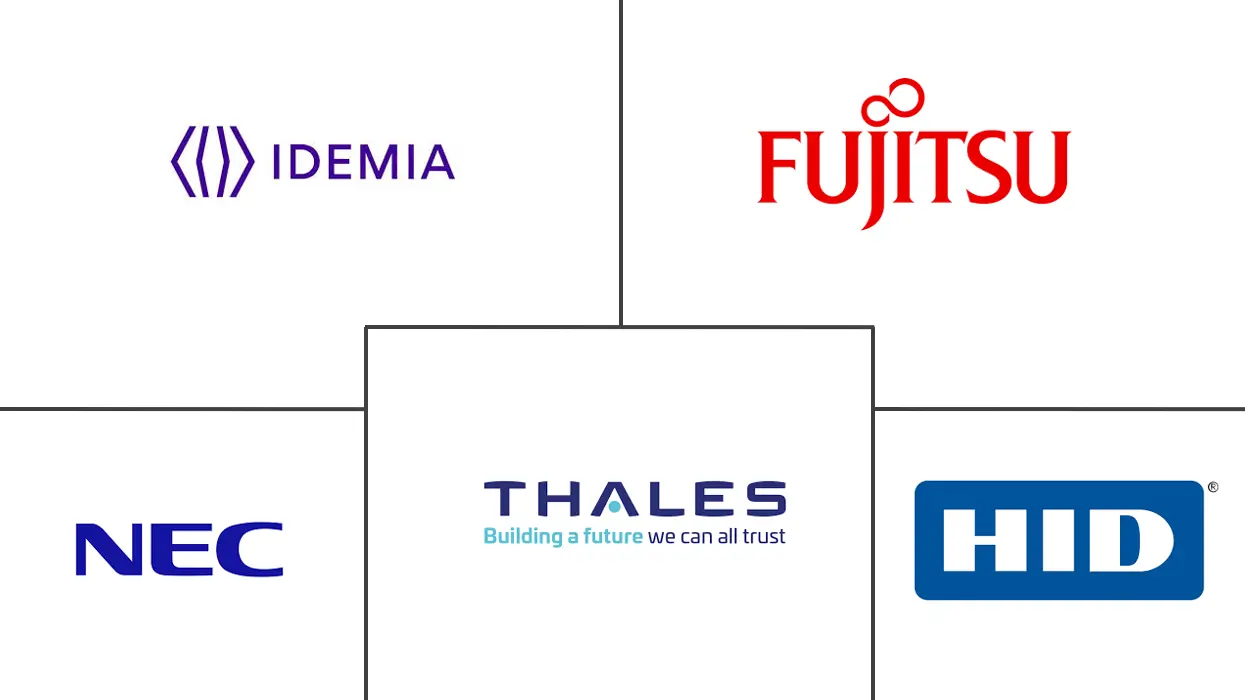Biometrics Market Size and Share
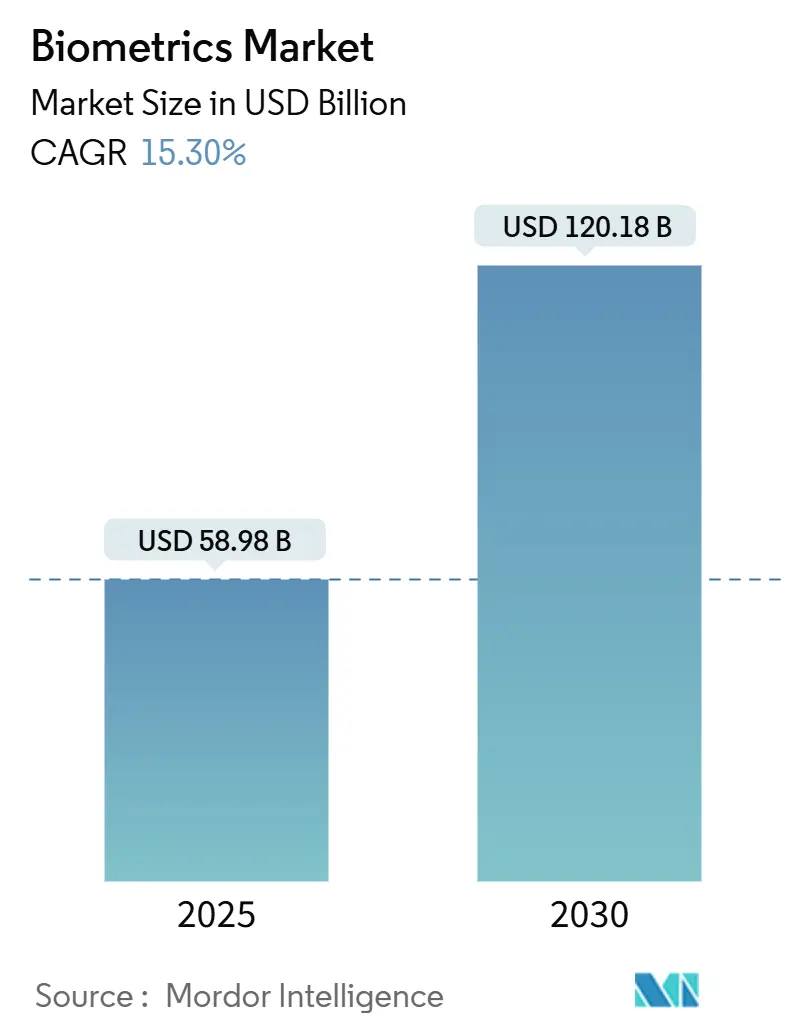
Biometrics Market Analysis by Mordor Intelligence
The biometrics market size is valued at USD 58.98 billion in 2025 and is forecast to expand to USD 120.18 billion by 2030, advancing at a 15.30% CAGR. The expansion is underpinned by government digital-ID programs, rising payments tokenization, and surging airport modernization that collectively elevate the need for frictionless identity proofing. Hardware still dominates current deployments, yet cloud-ready software engines are scaling fastest as enterprises shift from point solutions to platform models. New privacy regulations in China and the European Union are tightening compliance requirements, simultaneously encouraging multi-modal architectures that balance accuracy with consent management. In North America, REAL ID enforcement from May 2025 is driving an urgent wave of federal and state procurements for airport and DMV roll-outs. Asia Pacific’s integration of biometrics into super-apps, wallets, and bank e-KYC frameworks positions the region as the long-run demand accelerator.
Key Report Takeaways
- By component, hardware led with 42.5% revenue share in 2024 while software is projected to grow at a 16.6% CAGR to 2030.
- By biometric modality, fingerprint technology captured 37.0% of biometrics market share in 2024; iris recognition is forecast to expand at an 18.2% CAGR through 2030.
- By authentication type, single-factor methods held 64.1% share in 2024 whereas multi-factor approaches are advancing at a 17.1% CAGR.
- By contact type, contact-based systems accounted for 37.0% of the biometrics market size in 2024, and contactless solutions are expected to grow at a 17.1% CAGR.
- By application, physical and logical access control commanded 28.0% of the biometrics market size in 2024; payment and transaction authentication is rising at an 18.3% CAGR to 2030.
- By end-use industry, government and law-enforcement held 38.7% share of the biometrics market size in 2024, with healthcare growing fastest at 16.5% CAGR.
- By geography, North America dominated with 30.7% share in 2024, while Asia Pacific is poised for an 18.5% CAGR as digital wallets exceed 4.8 billion users globally.
Global Biometrics Market Trends and Insights
Drivers Impact Analysis
| Driver | (~) % Impact on CAGR Forecast | Geographic Relevance | Impact Timeline |
|---|---|---|---|
| Government-backed National e-ID Programs Across Asia | +3.20% | Asia Pacific core, spill-over to MEA | Medium term (2-4 years) |
| EMVCo and ISO Standards Catalyzing Fingerprint Payment Cards in North America and Europe | +2.80% | North America and EU | Short term (≤ 2 years) |
| U.S. TSA Biometrics Road-map Driving Federal Procurement Surge | +2.10% | North America, with early gains in major airports | Medium term (2-4 years) |
| China's "Smart Airport 2025" Policy Accelerating Face and Voice Biometrics | +1.90% | APAC core, spill-over to global aviation hubs | Short term (≤ 2 years) |
| Biometric KYC Mandates by GCC and African Central Banks | +1.70% | Middle East and Africa | Long term (≥ 4 years) |
| Healthcare Digital Transformation Driving Patient Identification Systems | +1.40% | Global, with concentration in developed markets | Medium term (2-4 years) |
| Source: Mordor Intelligence | |||
Government-backed National e-ID Programs Across Asia
Asian authorities are orchestrating large-scale digital identity transformations. South Korea’s smartphone-based resident registration card and Vietnam’s decision to extend biometric IDs to foreign nationals by July 2025 have set benchmarks for inclusive ecosystems. Indonesia’s USD 200 million INA Digital platform and the Philippines’ registration of 89.5 million citizens unlock financial services for previously unbanked adults. Sri Lanka’s multi-modal program combining fingerprints, face, and retina scans targets completion in 2026, illustrating how emerging economies leapfrog legacy infrastructures.
EMVCo and ISO Standards Catalyzing Fingerprint Payment Cards
Harmonized EMVCo and ISO rules have moved biometric cards from pilots to commercial issuance. Infineon’s SECORA Pay Bio silicon and Thales’ global trials cut false-accept rates and allow higher transaction ceilings [1] Infineon Technologies AG, “SECORA Pay Bio enhances convenience…,” infineon.com. Mastercard’s Identity Check and passkey support promise frictionless authentication, helping issuers reduce fraud and chargebacks. Vendors forecast shipments of 113.3 million biometric cards by 2028 as banks prioritize PIN-free contactless experiences.
U.S. TSA Biometrics Road-map Driving Federal Procurement Surge
The TSA is investing USD 250.8 million to expand face and fingerprint capture to hundreds of airport lanes by late 2025. Migration to the AI-enabled Homeland Advanced Recognition Technology system will process millions of passengers daily and spur mobile credential innovation through Cooperative Research and Development Agreements. REAL ID compliance gaps further lift demand for rapid, standards-based identity verification at DMVs and security checkpoints.
China’s “Smart Airport 2025” Policy Accelerating Face & Voice Biometrics
Beijing and Guangzhou airports demonstrate one-ID journeys blending face, voice, and behavior analytics that meet new personal-data filing requirements effective June 2025. A USD 12 billion pipeline of smart-airport upgrades channels funding into multi-modal kiosks that handle 100 million passengers annually. The legislated ban on facial recognition as a sole factor pushes airlines toward layered architectures that align with global privacy norms.
Restraints Impact Analysis
| Restraint | (~) % Impact on CAGR Forecast | Geographic Relevance | Impact Timeline |
|---|---|---|---|
| GDPR and BIPA Litigation Risks Curtailing Facial-Recognition Roll-outs | -2.40% | Global, with concentration in EU and Illinois | Short term (≤ 2 years) |
| Algorithmic Bias Against Dark-Skin Demographics Triggering Procurement Moratoriums | -1.80% | North America and EU | Medium term (2-4 years) |
| CMOS Image-Sensor Shortages Constricting Fingerprint Module Supply | -0.90% | Global, with concentration in Asia manufacturing hubs | Short term (≤ 2 years) |
| Supply Chain Disruptions and Component Cost Inflation | -0.70% | Global, with acute impact in semiconductor-dependent regions | Short term (≤ 2 years) |
| Source: Mordor Intelligence | |||
GDPR and BIPA Litigation Risks Curtailing Roll-outs
More than USD 200 million in BIPA settlements during 2024-2025, including Clearview AI’s USD 51.75 million payment, signals material liability for enterprises deploying facial recognition without explicit consent. GDPR’s strict data-minimization and local-processing rules add EUR 50,000-200,000 (USD 56,500-226,000) compliance cost per European installation, shrinking the addressable base for small projects. The FTC’s enforcement against Rite Aid sets a U.S. precedent for algorithmic-bias audits, compelling vendors to redesign architectures for privacy by design.
Algorithmic Bias Triggering Procurement Moratoriums
GAO findings on racial disparities in face-matching accuracy have led some municipalities to pause new procurements until vendors prove demographic fairness. DHS and DOJ are now weighting bias-mitigation scores in tender evaluations, lengthening sales cycles. IDEMIA’s top ranking in DHS fairness metrics underscores how intensive RandD into representative training data is becoming a competitive prerequisite.
Segment Analysis
By Component: Software Drives Innovation
Software engines grew from a supporting role to the highest-growth component at a 16.6% CAGR, even while hardware kept the 42.5 revenue share. Organizations value cloud orchestration, AI-based liveness detection, and decentralized identity wallets that continuously adapt to evolving fraud. Entrust’s acquisition of Onfido aligns with this trajectory, adding deep-fake countermeasures that improved forged-ID prevention five-fold.
The hardware segment remains indispensable where specialized sensors deliver cryptographic templates to secure elements. Infineon’s automotive-qualified fingerprint ICs illustrate how production-grade components expand the biometrics market into mobility and access domains. Services, while smallest, record consistent uptake as integrators customize multi-modal deployments for regulated industries.
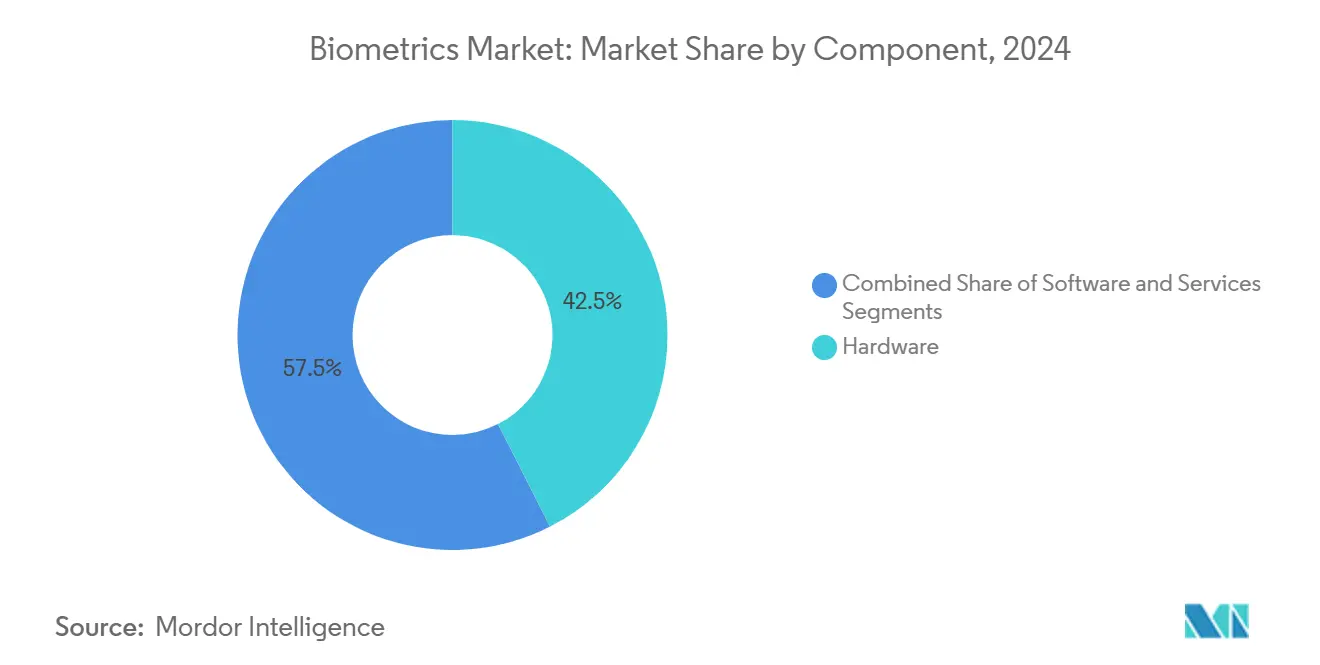
Note: Segment shares of all individual segments available upon report purchase
By Biometric Modality: Iris Recognition Emerges
Iris recognition posts an 18.2% CAGR, supported by liquid-lens optics that lower bill-of-material cost and shrink form factors. Fingerprint remains entrenched with 37.0% of biometrics market share in 2024, thanks to smartphones, payment cards, and time-clock systems. Facial recognition steadily penetrates airports and stadiums, while voice analytics gains footing in call-center authentication.
Behavioral biometrics, particularly gait and keystroke dynamics, add passive layers that elevate security without user friction. Mature fingerprint and facial solutions increasingly pair with iris, palm-vein, or voice modules in multi-modal kits, diversifying revenue and diluting single-modality risk.
By Contact Type: Contactless Transformation
Contactless modalities are scaling at 17.1% CAGR as hygiene and convenience trump legacy mindset. The biometrics market size for contact-based systems, despite a 37.0% share in 2024, is losing momentum to touchless fingerprint, face, and iris kiosks rolled out in healthcare and retail. ZKTeco identifies contactless preference as a long-term secular shift.
Invisible sensing, showcased by Continental’s in-vehicle camera-laser combo, morphs biometrics beyond access into wellness monitoring. AI improvements cut false rejects, moving touchless accuracy closer to contact-based benchmarks and satisfying high-assurance sectors.
By Authentication Type: Multi-Factor Momentum
Single-factor approaches still account for 64.1% of the 2024 installed base due to ease of deployment. Yet enterprises face deepfake escalations that expose stand-alone biometrics to spoofing. Multi-factor deployments, advancing at a 17.1% CAGR, layer device signals, behavioral analytics, and FIDO passkeys to harden security.
Meta’s patents that fuse vocalization with skin-vibration inputs illustrate how consumer platforms innovate to deliver zero-friction yet resilient sign-in flows. Continuous risk scoring allows adaptive step-ups only when anomalies surface, keeping user effort minimal
By Application: Payment Authentication Accelerates
Physical and logical access control retains the largest slice of the biometrics market size at 28.0%, bolstered by commercial real estate retrofits. Payment authentication, however, expands at an 18.3% CAGR, aided by Mastercard’s plan to replace 16-digit numbers with biometric tokens by 2030. Banks benefit from lower fraud and higher approval rates as PINs disappear from tap-to-pay journeys.
eKYC onboarding tools cut account-opening time from days to minutes, driving adoption in challenger banks and fintechs. Automotive OEMs test in-car payments linked to driver profiles, adding incremental volume to payment-focused vendors.
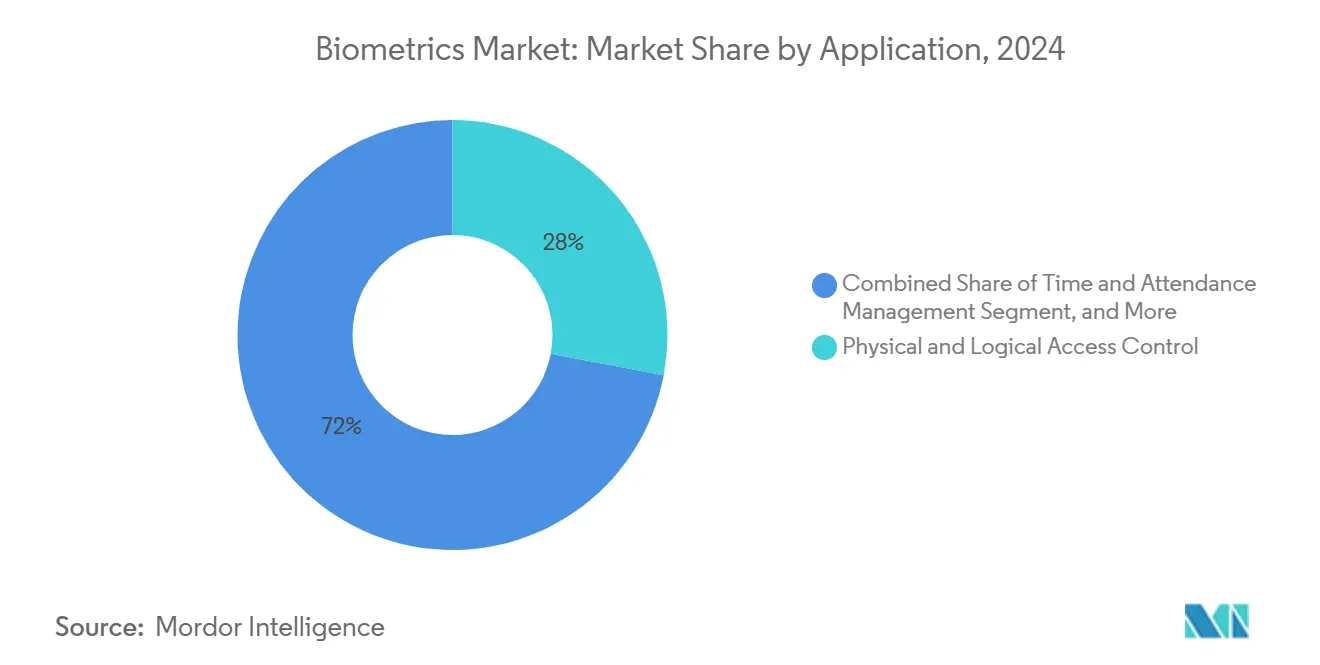
Note: Segment shares of all individual segments available upon report purchase
By End-Use Industry: Healthcare Transformation
Government and law-enforcement drove 38.7% of 2024 revenue by funding passport, border, and policing upgrades. Healthcare, growing at 16.5% CAGR, exemplifies next-wave potential. NYU Langone’s deployment of palm-vein scanning offers 99.9999% recognition accuracy, reducing duplicate medical records and fraud.
Electronic health record integration and medication-dispensing audits fuel demand for iris and face biometrics. Insurance carriers follow by linking claims processing to verified patient identities, tightening leakage across the care continuum.
Geography Analysis
North America produced 30.7% of global revenue in 2024, anchored by federal budgets and widespread private-sector adoption. TSA’s accelerating lane expansions and DHS’s USD 250.8 million line-item for identity management provide a multi-year demand floor for vendors [2]Security Info Watch, “TSA Speeds Millions Through Airports…,” securityinfowatch.com. Canada and Mexico modernize land-border e-gates to streamline trade, reinforcing continental scale.
Asia Pacific records the steepest trajectory with an 18.5% CAGR forecast to 2030. South Korea’s nationwide mobile-ID completion, China’s codified face-recognition rules, and India’s Aadhaar-linked pay services cultivate a unified biometrics market bigger than any single-country program. The region’s 4.8 billion digital-wallet users push biometric KYC from optional to mandatory across banks and telecoms.
Europe’s growth remains steady under strict GDPR oversight. The EU Entry/Exit System rolls out border biometrics across Schengen states, while the United Kingdom’s new trust framework fosters private-sector credential innovation. Nordic pilots prove that on-device processing can satisfy privacy watchdogs without sacrificing speed, shaping procurement criteria across the continent.
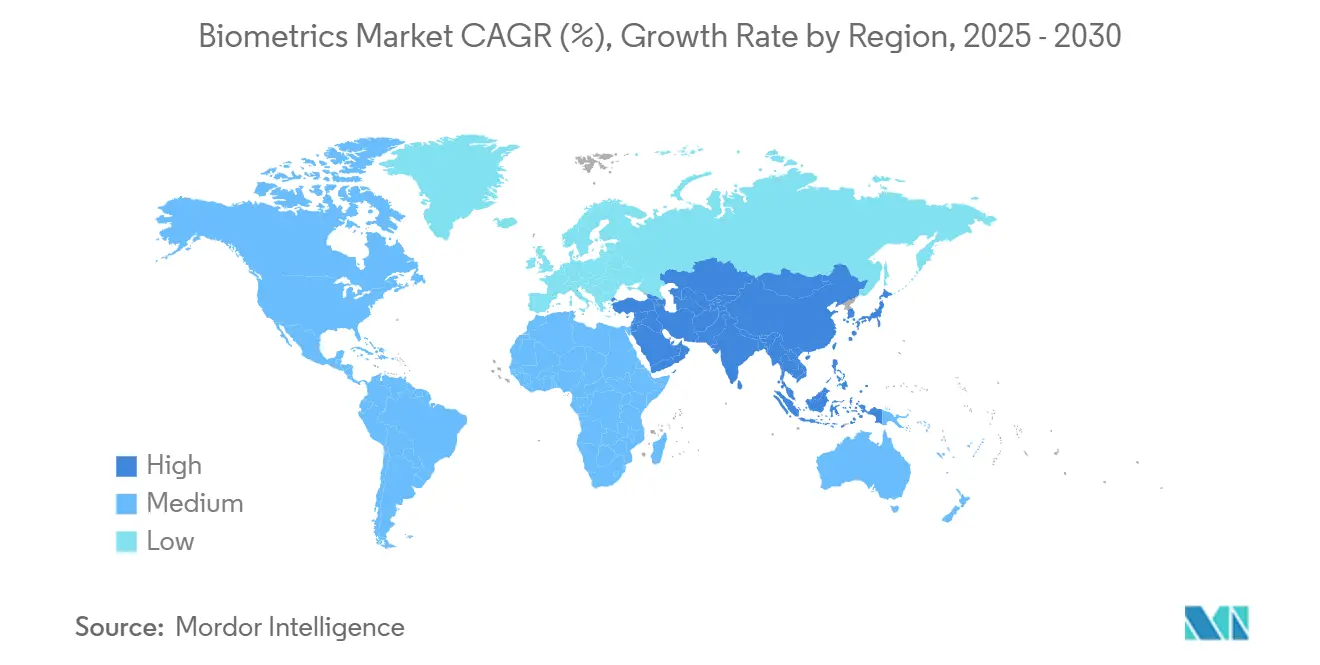
Competitive Landscape
The biometrics market exhibits moderate consolidation as incumbents buy niche capabilities to satisfy rising regulatory and technical complexity. Entrust closed its Onfido deal to integrate AI-driven forgery detection, targeting enterprises confronting deepfake attacks. IN Groupe’s planned EUR 1 billion (USD 1.13 billion) purchase of IDEMIA Smart Identity would forge a EUR 1 billion-plus revenue powerhouse with diversified geographic reach[3]Security World Market, “IN Groupe set to acquire Smart Identity division…,” securityworldmarket.com.
Strategic alliances pursue standards compliance: Infineon and Fingerprint Cards co-developed SECORA Pay Bio, passing Visa and Mastercard thresholds for commercial launch. Patent analytics show Microsoft, Oracle, and Bank of America filing blockchain and biometric verification patents, underscoring how big-tech and financial institutions converge on decentralized identity.
Emerging disruptors focus on vertical niches. Wink’s merger with Phoenix Managed Networks addresses omnichannel retail, while BioCenturion targets iris and behavioral fusion for defense. Automotive, healthcare, and payment tokens remain under-penetrated white spaces where differentiated UX and compliance acumen translate into margin expansion.
Biometrics Industry Leaders
-
Fujitsu Limited
-
NEC Corporation
-
HID Global Corporation
-
IDEMIA France SAS
-
Thales Group
- *Disclaimer: Major Players sorted in no particular order
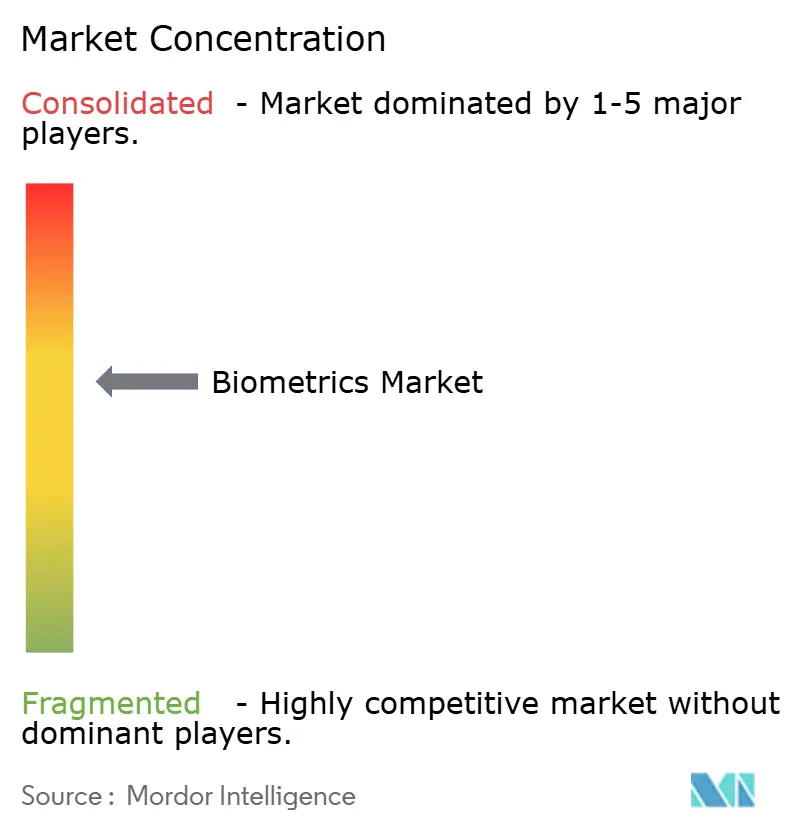
Recent Industry Developments
- March 2025: IN Groupe finalized talks to acquire IDEMIA Smart Identity for over EUR 1 billion (USD 1.13 billion), seeking scale economies in public-sector tenders.
- February 2025: Mastercard pledged to retire 16-digit card numbers by 2030, anchoring its risk strategy on on-device biometrics and network tokenization.
- January 2025: ASSA ABLOY agreed to acquire 3millID and Third Millennium for USD 21 million, expanding HID Global’s channel for converged access solutions.
- December 2024: Gentex announced an all-cash takeover of VOXX International to secure iris-authentication IP for mobility and aerospace adjacencies.
Global Biometrics Market Report Scope
The Biometrics Market is segmented by Type (Hardware, Software, and Services), Biometric Type (IRIS Recognition, Hand Geometry, Facial Recognition, Signature Verification, Fingerprint, Voice Recognition, Palm Vein), Contact Type (Contact-based, Non-contact Based), End User (Government and Law Enforcement, Commercial and Retail, Healthcare, BFSI, Travel, and Immigration), and Geography.
Biometrics refers to the measurement and statistical analysis of an individual's unique physical and behavioral characteristics. It is mainly used for identification and access control or for identifying individuals who are under surveillance.
| Hardware |
| Software |
| Services |
| Physiological Biometrics | Fingerprint AFIS |
| Fingerprint Non-AFIS (Automated Fingerprint Identification System) | |
| Facial Recognition | |
| Iris Recognition | |
| Others (Palm Vein, Hand Geometry) | |
| Behavioral Biometrics | Voice Recognition |
| Signature Verification | |
| Others (Gait Analysis, Keystroke Dynamics) |
| Contact-based |
| Contactless |
| Hybrid |
| Single-factor |
| Multi-factor |
| Physical and Logical Access Control |
| Time and Attendance Management |
| Payment and Transaction Authentication |
| e-Passport and Border Control |
| Patient Identification and EHR Security |
| Customer On-boarding (eKYC) |
| Public Surveillance and Safety |
| Automotive and Smart Vehicle Interfaces |
| Government and Law Enforcement |
| BFSI |
| Healthcare |
| Consumer Electronics |
| Commercial and Retail |
| Travel and Immigration |
| Military and Defense |
| Automotive |
| Education |
| Others |
| North America | United States | |
| Canada | ||
| Mexico | ||
| South America | Brazil | |
| Argentina | ||
| Rest of South America | ||
| Europe | United Kingdom | |
| Germany | ||
| France | ||
| Italy | ||
| Spain | ||
| Nordics | ||
| Russia | ||
| Rest of Europe | ||
| Asia Pacific | China | |
| Japan | ||
| South Korea | ||
| India | ||
| ASEAN | ||
| Australia | ||
| New Zealand | ||
| Rest of Asia Paccific | ||
| Middle East and Africa | Middle East | Saudi Arabia |
| United Arab Emirates | ||
| Turkey | ||
| Israel | ||
| Rest of Middle East | ||
| Africa | South Africa | |
| Nigeria | ||
| Kenya | ||
| Rest of Africa | ||
| By Component | Hardware | ||
| Software | |||
| Services | |||
| By Biometric Modality | Physiological Biometrics | Fingerprint AFIS | |
| Fingerprint Non-AFIS (Automated Fingerprint Identification System) | |||
| Facial Recognition | |||
| Iris Recognition | |||
| Others (Palm Vein, Hand Geometry) | |||
| Behavioral Biometrics | Voice Recognition | ||
| Signature Verification | |||
| Others (Gait Analysis, Keystroke Dynamics) | |||
| By Contact Type | Contact-based | ||
| Contactless | |||
| Hybrid | |||
| By Authentication Type | Single-factor | ||
| Multi-factor | |||
| By Application | Physical and Logical Access Control | ||
| Time and Attendance Management | |||
| Payment and Transaction Authentication | |||
| e-Passport and Border Control | |||
| Patient Identification and EHR Security | |||
| Customer On-boarding (eKYC) | |||
| Public Surveillance and Safety | |||
| Automotive and Smart Vehicle Interfaces | |||
| By End-Use Industry | Government and Law Enforcement | ||
| BFSI | |||
| Healthcare | |||
| Consumer Electronics | |||
| Commercial and Retail | |||
| Travel and Immigration | |||
| Military and Defense | |||
| Automotive | |||
| Education | |||
| Others | |||
| By Geography | North America | United States | |
| Canada | |||
| Mexico | |||
| South America | Brazil | ||
| Argentina | |||
| Rest of South America | |||
| Europe | United Kingdom | ||
| Germany | |||
| France | |||
| Italy | |||
| Spain | |||
| Nordics | |||
| Russia | |||
| Rest of Europe | |||
| Asia Pacific | China | ||
| Japan | |||
| South Korea | |||
| India | |||
| ASEAN | |||
| Australia | |||
| New Zealand | |||
| Rest of Asia Paccific | |||
| Middle East and Africa | Middle East | Saudi Arabia | |
| United Arab Emirates | |||
| Turkey | |||
| Israel | |||
| Rest of Middle East | |||
| Africa | South Africa | ||
| Nigeria | |||
| Kenya | |||
| Rest of Africa | |||
Key Questions Answered in the Report
What is the current size of the biometrics market?
The biometrics market stands at USD 58.98 billion in 2025 and is projected to more than double to USD 120.18 billion by 2030.
Which component segment is growing fastest?
Software leads growth with a 16.6% CAGR as enterprises integrate AI-driven liveness and cloud orchestration.
Why is Asia Pacific the fastest-growing region?
Government digital-ID programs, mobile wallets, and financial-inclusion mandates power an 18.5% CAGR across the region.
How are regulatory risks affecting deployments?
GDPR and BIPA compliance costs plus litigation risks can reduce planned roll-outs by as much as 2.4 percentage points of CAGR, especially in Europe and Illinois.
Page last updated on:
